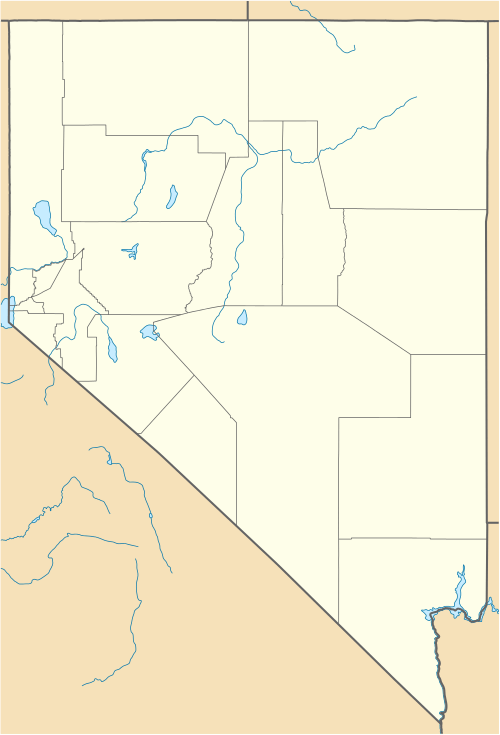Cathedral Gorge State Park
| Cathedral Gorge State Park | |
| Nevada State Park | |
.jpg) Columns and spires eroded into a bentonite formation | |
| Country | |
|---|---|
| State | |
| County | Lincoln |
| Location | Panaca |
| - elevation | 4,819 ft (1,469 m) [1] |
| - coordinates | 37°49′20″N 114°25′0″W / 37.82222°N 114.41667°WCoordinates: 37°49′20″N 114°25′0″W / 37.82222°N 114.41667°W |
| Area | 1,608 acres (651 ha) |
| Founded | 1935 |
| Management | Nevada Division of State Parks |
 Location of Cathedral Gorge State Park in Nevada
| |
Cathedral Gorge State Park is a state park of Nevada, USA, featuring a gorge eroded through soft bentonite clay. The park covers 1,608 acres (651 ha). It is located in Central/Eastern Nevada along U.S. Route 93, 1 mile (1.6 km) north of the west end of State Route 319, near Panaca. Cathedral Gorge was established as one of the four original Nevada State Parks in 1935. The park sits at an elevation of 4,800 feet (1,500 m) above sea level, and is typically arid with semi-hot summers, and very cold winters. In the summer, temperatures usually range from 95 °F (35 °C) in midday to roughly 55 °F (13 °C) at night. Rainfall is variable, and thunderstorms are prevalent. At one time, Shakespearean plays were performed with the clay formations in the backdrop. The various naturally formed crevices were used as dressing rooms and as a backstage where actors and actresses would prepare, awaiting their cue.
Natural history

Geology
A majority of Meadow Valley (which lies along U.S. Route 93 from the towns of Caliente to Panaca) was covered by a freshwater lake nearly 1 million years ago during the Pliocene Era. The richly colored canyons of Cathedral Gorge (called the Panaca Formation) are remnants of this ancient lakebed. Over centuries, the lake began to gradually drain. Erosion began working away at the exposed portions of sediment and gravel that once composed the lake bottom. Rainwater and melting snow carved rivulets in the soft siltstone and clay shale, splitting tiny cracks and fissures into larger and larger gullies and canyons.
Plants
In areas below the eroded escarpment (dubbed the "Badland") it is difficult for plant life to take root in the constantly eroding clay. However, away from the clay, the park's diverse soil types allow various plant associations to grow. Fragile sand dunes are held firm thanks to a wide array of wildflowers and grasses, such as Dune Primroses and Indian Rice Grass. Within the valley center, clay, sand, and gravel have melded to form a rich, granulated soil that encourages the growth of the following species: narrowleaf yucca, juniper trees, Barberry sagebrush, greasewood, white sage, shadscale, Four-winged Saltbush. Rabbitbrush finds sanctuary in disturbed areas, such as roadsides and walkways. Very few species of cactus can tolerate the climate in Cathedral Gorge, where temperatures in winter can fall below freezing, and rise above 100 °F (38 °C) in summer.
Other trees, not native to the park, have been planted around the campground to provide shade.
Animals
Small mammals form a majority of the park's animal population: black-tailed jackrabbits, cottontail rabbits, coyotes, gophers, kangaroo rats, kit foxes, mice, and skunks. Deer can be observed infrequently near Miller Point during the late fall and winter.
Birds are seen frequently around camp areas and near dense patches of shrubs. The natives include blackbirds, black-throated sparrows, finches, American kestrels, small hawks, ravens, roadrunners, American robins, sapsuckers, and introduced European starlings. Migratory birds include bluebirds, cedar waxwings, hummingbirds, and warblers.
Various species of non-poisonous snakes and lizards are abundant. In the summer, the Great Basin rattlesnake may be spotted.
Activities
Camping, hiking, photography, slot canyon exploring, wildlife viewing, and star gazing are all activities that can be done at Cathedral Gorge.
The Park has a 24 site campground with 30 and 50 amp service at each site. Two ADA Accessible sites are next to the group use area. Water is available at the RV dump station and in the campground. Bathrooms with hot showers are available in the campground and group use area. All sites are first come, first served.
Slot Canyons: Explore the narrow canyons cut deep into the old muds that millions of years ago were at the bottom of the lake. Adventurous explorers can crawl through tunnels to discover hidden chambers in the network of canyons. All explorers will appreciate the coolness of the canyons in the summer heat.
Trails: Six developed trails highlight areas of the park.
Bullionville Trail: Easy .05 mile walk up to the Bullionville Cemetery from the Visitor Center.
Nature Trail: Interpretative signs along the way tell about the park’s plants and animals. This easy .5 loop crosses two washes and leads from the campground to the slot canyons in the day-use area.
Juniper Draw Loop: Flat and sandy, this three mile loop follows formations around the valley floor.
Miller Point Trail: A moderate two mile trail through a canyon and up a series of stairs to Miller Point.
Eagle View Trail: Offering a bird’s eye view of the entire park this 1.6 mile round-trip trail follows a ridge line to the Eagle Viewpoint where you can sit on a bench and enjoy the scenery.
New Ridge-line Trail: This trail is 4.2 miles long. It takes off from the Juniper Draw Trail, winds through some formations then follows the ridge-line around the park.
A Regional Visitor Center, located at the park entrance, has interpretive displays and information about the other five state parks in the area: Beaver Dam, Echo Canyon, Kershaw-Ryan, and Spring Valley State Parks.
References
- ↑ "Cathedral Gorge State Park". Geographic Names Information System. United States Geological Survey. 1980-12-12. Retrieved 2011-03-31.
External links
| Wikimedia Commons has media related to Cathedral Gorge State Park. |
- Cathedral Gorge State Park (Nevada State Parks)
- Cathedral Gorge State Park, NV (DesertUSA)